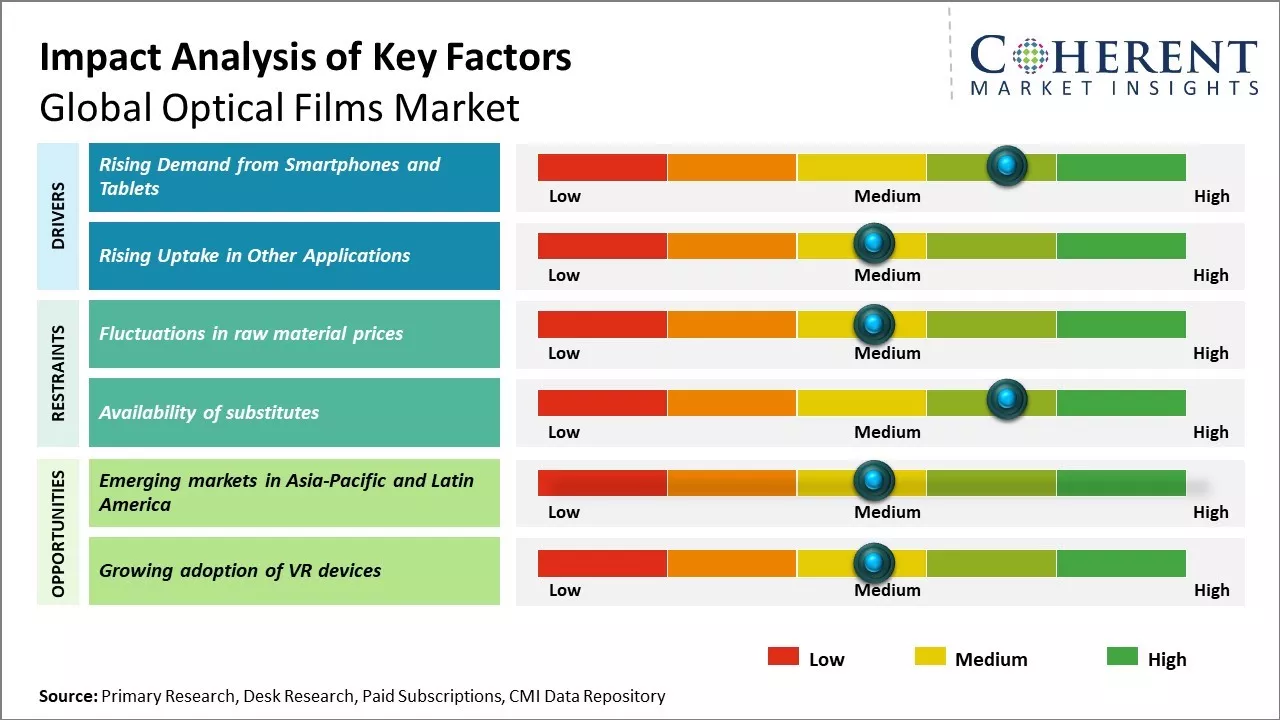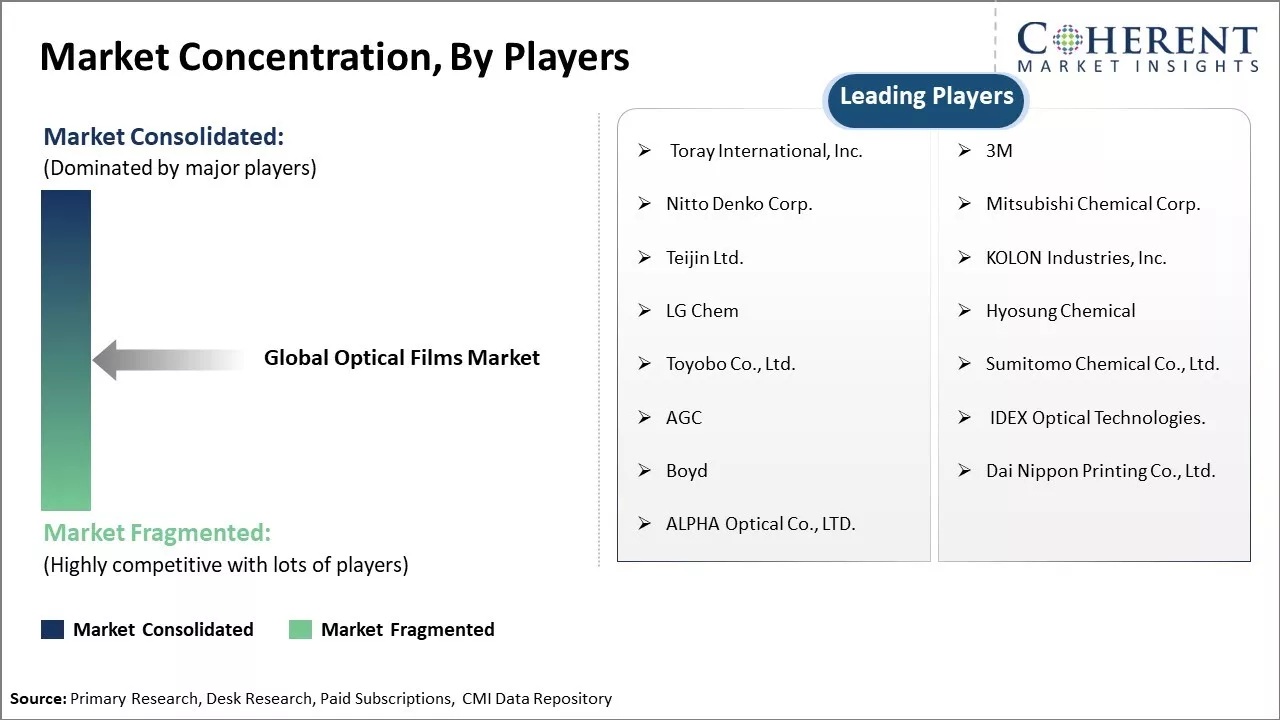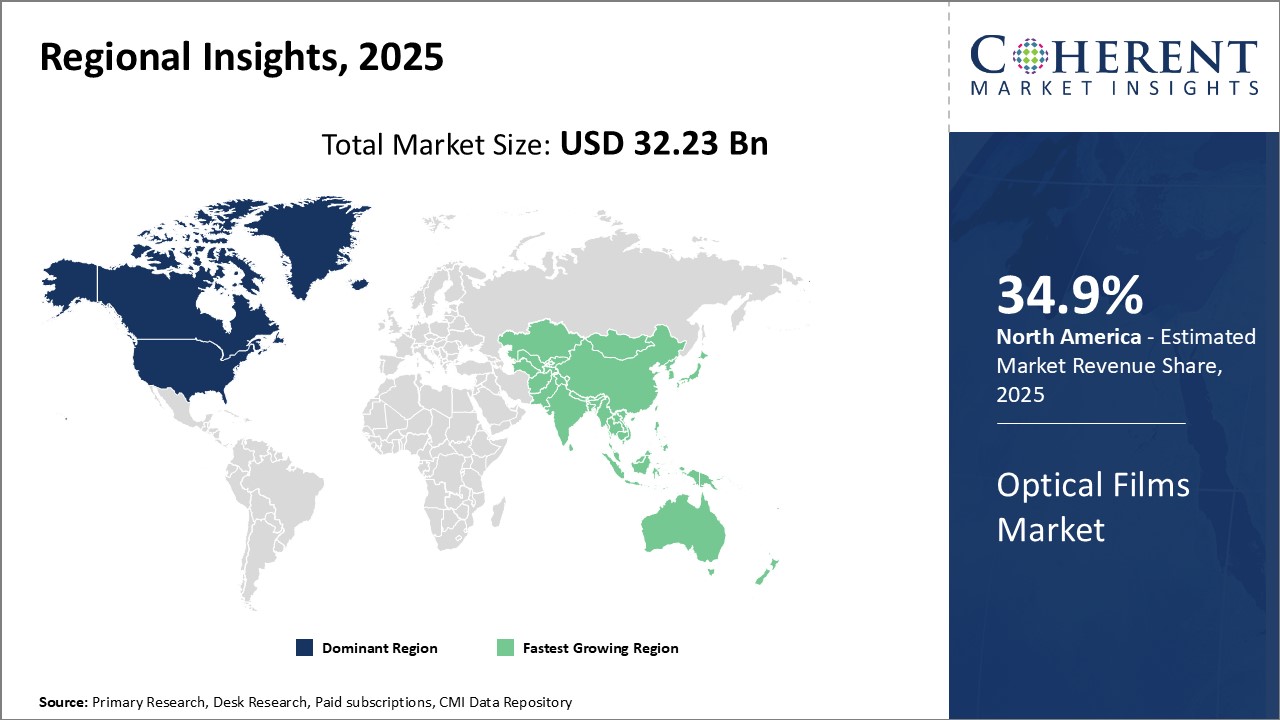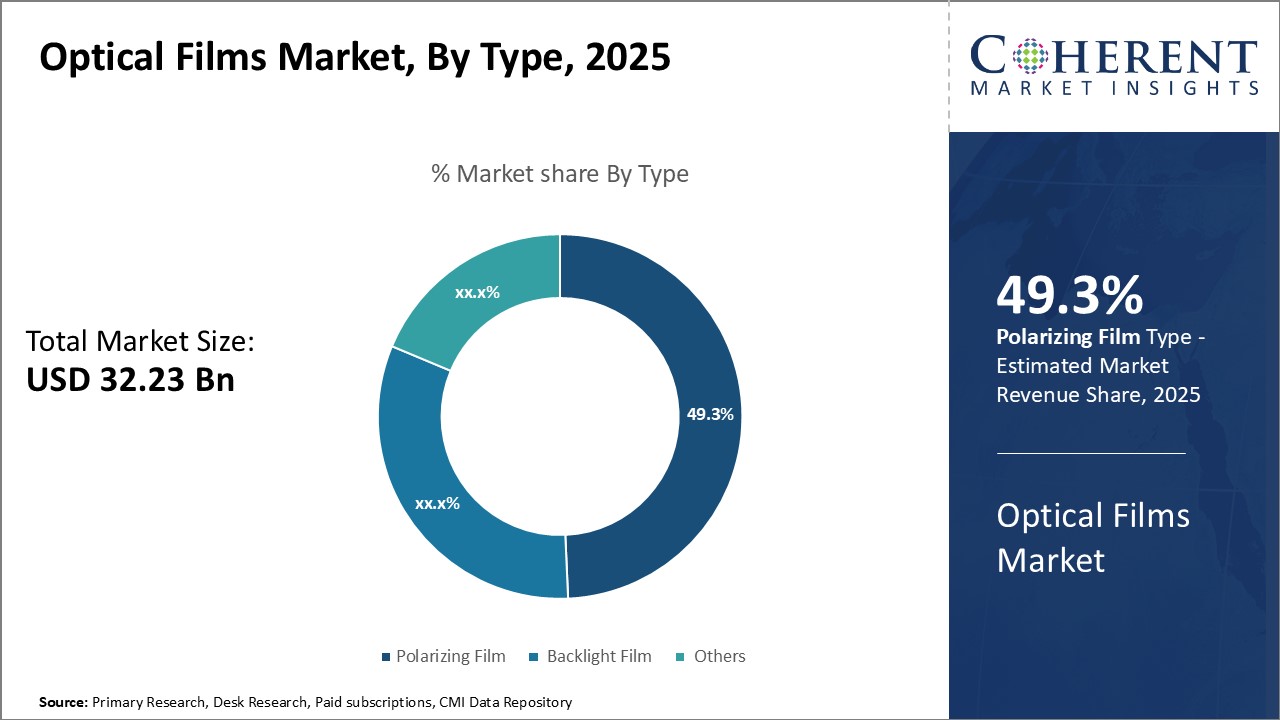The optical films market is estimated to be valued at USD 32.23 Bn in 2025 and is expected to reach USD 57.83 Bn by 2032, exhibiting a compound annual growth rate (CAGR) of 8.7% from 2025 to 2032.

To learn more about this report, Download Free Sample
Key Takeaways:
- By Type, The Polarizing Film Segment is projected to dominate the global optical films market, securing approximately 49.3% of the market share in 2025.
- By Application, Smartphones Division is expected to command a significant share in the optical films market, accounting for approximately 41% of the market share in 2025.
- By Region, North America is anticipated to maintain its leadership position in the global optical films market, with an estimated 34.9% market share in 2025.
Market Overview:
The global Optical Films Market is witnessing consistent growth, fuelled by the expanding demand for high-performance display technologies across consumer electronics, automotive, and advertising sectors. Key drivers include the rising penetration of smartphones, advancements in display panels, and growing adoption of energy-efficient screens. Polarizing films dominate the type segment, while smartphones lead the application category.
Current Events and Its Impact on The Optical Films Market
|
Current Event |
Description and its impact |
|
Supply Chain Disruptions in Asia-Pacific Electronics Manufacturing |
|
|
Growth in Electric Vehicles and Smart Automotive Displays |
|
|
Expansion of OLED and Flexible Display Technologies |
|
Uncover macros and micros vetted on 75+ parameters: Get instant access to report
Pricing Analysis: Optical films market
The pricing structure of the global Optical Films Market is influenced by several interconnected factors, including film type, material composition, thickness, end-use application, and performance attributes such as light transmission, durability, and flexibility.
Premium pricing is typically associated with high-performance polarizing films and anti-reflective coatings used in advanced display technologies like OLEDs, foldable screens, and automotive HUDs, due to their complex manufacturing processes and stringent optical performance standards.
Rising demand for energy-efficient and ultra-thin films in high-resolution devices is contributing to elevated production costs, especially in regions with sophisticated manufacturing capabilities such as Japan, South Korea, and the United States. Additionally, fluctuations in raw material prices—particularly for polymers like PET and TAC—directly affect overall film pricing, with sustainability mandates and recycling requirements adding further cost considerations.
Regional disparities in labor costs and manufacturing scale also drive pricing variation, with Asia Pacific offering more cost-competitive options due to mass production economies. Conversely, North America and Europe tend to see higher average prices due to tighter environmental regulations, labor expenses, and customized production needs. As competition intensifies and innovation scales up, pricing models are shifting toward value-based offerings, where performance and longevity justify premium rates. Despite these dynamics, technological advancements and material innovations are expected to gradually offset cost pressures over time.
Technological Advancements, Consumer Feedback, and Unmet Demands: Optical films market
Technological advancements are driving transformative change in the optical films market. Developments in nanotechnology, multi-layer coating techniques, and advanced polymer engineering are enabling the production of thinner, lighter, and more durable films with enhanced optical properties.
Innovations such as quantum dot enhancement films (QDEF), anti-glare and anti-reflective coatings, and flexible optical substrates are expanding applications in next-generation displays, automotive HUDs, and foldable devices. Furthermore, automation and precision manufacturing technologies are improving production efficiency and consistency, reducing defects in high-performance film applications.
Consumer feedback underscores the growing demand for higher brightness, improved contrast ratios, and energy-efficient screen displays. Users increasingly prefer displays with better outdoor visibility and minimal glare, especially in smartphones, tablets, and automotive screens.
Manufacturers are also under pressure to provide eco-friendly and recyclable film materials to meet rising sustainability expectations. From industrial clients to tech-savvy consumers, there is a clear preference for high-quality, reliable, and environmentally conscious optical solutions.
Unmet demands persist in areas such as cost-effective high-performance films and environmentally sustainable alternatives to traditional materials like TAC and PET. Small- and mid-scale display manufacturers face challenges in accessing advanced coating technologies due to high capital costs.
Additionally, there is a gap in localized supply chains, leading to increased lead times and logistics costs. Addressing these challenges through decentralized production capabilities, affordable innovation, and recyclable material development is critical to meeting market demands and achieving long-term sustainability in the optical films industry.
Market Concentration and Competitive Landscape

To learn more about this report, Download Free Sample
Market Dynamics
Optical films market Trends
-
Rising Demand from Smartphones and Tablets
The demand for optical films is experiencing significant growth due to the increasing usage of smartphones and tablets across the world. As the screens of these devices become larger with higher resolution, it requires sophisticated optical films like polarizing films and compensation films to deliver crisp images without distortions.
Manufacturers are constantly focusing on enhancing the viewing experience by reducing reflections and improving color reproduction and contrast on electronic displays. This has significantly boosted the consumption of optical films in these devices. It is estimated that a high-end smartphone today uses around four to five films in its construction.
In February 2025, the European Commission unconditionally approved Nokia's $2.3 billion acquisition of U.S.-based optical semiconductors and networking equipment maker Infinera. This deal positions Nokia as the second-largest vendor in the optical networking market with a 20% share, enhancing its ability to serve major tech companies investing in data centers.
-
Rising Uptake in Other Applications
Interestingly, optical films are finding wider applications beyond smartphones and seeing increased usage in various other sectors as well. The demand is increasing from TVs as manufacturers integrate larger screens and curved designs. The TV market is characterized by continuous innovations and replacements which augur well for optical film consumption.
Similarly, the evolution of virtual and augmented reality headsets relies on optical films for blocking outside light and ensuring clarity of images. With VR/AR expected to transform multiple industries and gain mass adoption in the next 5 years, it will open new avenues for optical film vendors. Automotive is another sector gaining attention with the integration of arger displays as part of the connected car initiative.
In May 2025, Gooch & Housego (G&H), a UK-based photonics technology company, announced the acquisition of Global Photonics, a U.S.-based developer of military and aerospace-focused optical systems and thin film coatings. This strategic acquisition aims to strengthen G&H's Optical Systems division and establish a U.S. Center of Excellence for Optical Systems in Tampa, Florida.
By integrating Global Photonics' expertise in cleanroom lithography, photolithographic reticle fabrication, ion beam etching, and advanced thin film coatings, G&H seeks to enhance its capabilities in the defense and aerospace optics market. The move is expected to accelerate G&H's growth in North America and solidify its position as a partner of choice for high-precision optical systems.
Opportunities in the Optical films market
Emerging markets in Asia-Pacific and Latin America
Emerging markets in Asia-Pacific and Latin America show tremendous potential for growth in the global optical films market. These regions are experiencing significant economic development which is increasing consumer spending power. As incomes rise, more people will be able to afford electronic devices that use optical films like smartphones, tablets, laptops, TVs and home appliances.
The growing middle-class populations in countries like India, Indonesia, Brazil and Mexico indicate a huge latent demand for both consumer and commercial end-use products equipped with optical films.
Optical Films Market Insights, By Type
The Polarizing Film segment is projected to dominate the global Optical Films Market, securing approximately 49.3% of the market share in 2025. This leading position is primarily driven by the rising integration of polarizing films in advanced display technologies, especially in LCD and OLED panels.
These films enhance display readability by managing light transmission and contrast, making them indispensable in smartphones, televisions, automotive displays, and other screen-based devices. Additionally, advancements in flexible and ultra-thin polarizing film technologies are expanding application possibilities across next-generation displays, further reinforcing this segment’s dominance.
Optical Films Market Insights, By Application
Smartphones are expected to command a significant share in the Optical Films Market, accounting for approximately 41% of the market share in 2025. This dominance is fuelled by the continuous rise in smartphone adoption globally and growing consumer demand for high-performance visual displays.
As manufacturers focus on delivering bezel-less, foldable, and high-refresh-rate screens, the need for superior optical films with enhanced brightness, color accuracy, and durability is surging. The increase in mobile internet usage, gaming, and video streaming is also pushing OEMs to integrate more sophisticated optical components, driving growth in this application segment.
Optical films market: Regional Insight

To learn more about this report, Download Free Sample
North America Optical Films Market Trends and Analysis
North America is anticipated to maintain its leadership position in the global optical films market, with an estimated 34.9% market share in 2025. This regional dominance is supported by the strong presence of advanced display manufacturers, robust R&D infrastructure, and rising demand for high-performance electronic devices.
The U.S. market continues to lead due to growing adoption of OLED and LCD technologies in smartphones, televisions, and automotive displays. Government support for technology innovation and close collaborations between research institutions and industry players are further reinforcing North America's position in the optical films space.
Europe Optical Films Market Trends and Analysis
Europe is expected to hold a significant share of the global Optical Films Market through 2025, driven by demand for energy-efficient display solutions and a strong consumer electronics sector. Countries such as Germany, the UK, and France are focusing on integrating eco-friendly and recyclable materials in display technologies, which is accelerating innovation in optical film coatings. Additionally, the automotive sector’s growth in digital cockpit displays and infotainment systems is contributing to increased adoption of advanced optical films across the region.
Optical films market Dominating Countries:
United States and Canada Optical Films Market Analysis and Trends
The United States and Canada are leading countries in the North American Optical Films Market, which is projected to hold a dominant 34.9% market share in 2025. The U.S. drives market growth through its advanced consumer electronics industry, particularly in smartphones, televisions, and automotive displays. Its strong R&D ecosystem, supported by collaborations between tech giants and display manufacturers, is fostering continuous innovation in polarizing and backlight films.
Canada contributes through its emphasis on sustainable materials and energy-efficient technologies, aligning with regional demand for high-performance, eco-friendly optical films.
Market Report Scope
Optical Films Market Report Coverage
| Report Coverage | Details | ||
|---|---|---|---|
| Base Year: | 2024 | Market Size in 2025: | USD 32.23 Bn |
| Historical Data for: | 2020 To 2024 | Forecast Period: | 2025 To 2032 |
| Forecast Period 2025 to 2032 CAGR: | 8.7% | 2032 Value Projection: | USD 57.83 Bn |
| Geographies covered: |
|
||
| Segments covered: |
|
||
| Companies covered: |
Toray International, Inc., 3M, Nitto Denko Corp., Mitsubishi Chemical Corp., Teijin Ltd., KOLON Industries, Inc., LG Chem, Hyosung Chemical, Toyobo Co., Ltd., Sumitomo Chemical Co., Ltd., AGC, IDEX Optical Technologies. , Boyd, Dai Nippon Printing Co., Ltd., and ALPHA Optical Co., LTD. |
||
| Growth Drivers: |
|
||
| Restraints & Challenges: |
|
||
Uncover macros and micros vetted on 75+ parameters: Get instant access to report
Analyst Viewpoint Optical films market
- The global Optical Films market is witnessing robust growth, driven by escalating demand for advanced display technologies across consumer electronics, automotive, and signage sectors. The growth is also fueled by innovations in flexible, thinner, and higher-efficiency films critical for LCD and OLED displays. Rising consumer preference for high-resolution, energy-efficient, and durable screens is further propelling adoption.
- Experts emphasize that smartphones will continue to be the largest application segment, accounting for approximately 41% of the market in 2025. The surge in mobile internet penetration, trend toward bezel-less and foldable displays, and demand for superior visual experience are key drivers. Additionally, the growing importance of eco-friendly and recyclable film materials is shaping product development priorities within the industry.
- Regionally, North America maintains its leadership position with an estimated 34.9% market share in 2025, supported by a strong manufacturing base, substantial R&D investments, and presence of major display and electronics companies. Meanwhile, Asia Pacific is identified as the fastest-growing region, propelled by expanding electronics manufacturing hubs, government support for innovation, and rising demand for consumer and automotive displays.
Optical films market: Key Development
- In May 2025, 3M Corporation launched a new line of ultra-thin polarizing films designed for next-generation flexible OLED displays. This innovation aims to enhance display brightness and durability while reducing power consumption, responding to the rising demand for advanced wearable and foldable electronic devices.
- In April 2025, Eastman Chemical Company expanded its optical films manufacturing capacity in Asia Pacific with a new state-of-the-art facility in South Korea. The expansion supports growing regional demand for high-performance films used in smartphones, automotive displays, and large-format signage.
- In March 2025, Mitsubishi Chemical partnered with a leading automotive manufacturer to develop customized optical films tailored for heads-up displays (HUDs) and augmented reality (AR) applications. This collaboration focuses on improving light transmission and reducing glare in automotive environments.
- In February 2025, LG Chem introduced a recyclable, eco-friendly optical film portfolio aimed at reducing environmental impact across consumer electronics. This move aligns with global sustainability trends and increasing regulatory pressures on plastic waste management.
- In January 2025, Nippon Kayaku Co., Ltd. acquired a specialty film technology startup focused on nano-structured coatings that enhance optical clarity and anti-reflective properties. This acquisition strengthens Nippon Kayaku’s position in high-performance display materials and next-gen optical film innovation.
Key Players Insights
- Toray International, Inc.
- 3M
- Nitto Denko Corp.
- Mitsubishi Chemical Corp.
- Teijin Ltd.
- KOLON Industries, Inc.
- LG Chem
- Hyosung Chemical
- Toyobo Co., Ltd.
- Sumitomo Chemical Co., Ltd.
- AGC
- IDEX Optical Technologies.
- Boyd
- Dai Nippon Printing Co., Ltd.
- ALPHA Optical Co., LTD.
Sources
The Stakeholders Consulted:
- Manufacturers and suppliers of optical films and related materials
- Display technology and electronics manufacturers
- Automotive industry component engineers and R&D teams
- Consumer electronics product designers and innovation managers
- Research institutions specializing in material science and optical technologies
- Regulatory authorities overseeing materials and environmental standards
- Industry consultants focused on display technologies and sustainable materials
Databases Opened:
- International Trade Centre (ITC) – Trade Statistics on Optical Components
- World Bank Open Data – Manufacturing and Materials Metrics
- U.S. Geological Survey (USGS) – Mineral and Material Supply Data
Magazines & Trade Publications:
- Display Daily
- Optics & Photonics News
- Materials Today
- LEDinside – Market Analysis and Trends
- Automotive Display Magazine
- Electronics Weekly – Display and Materials Section
Scientific and Industry Journals:
- Journal of Applied Polymer Science
- Optical Materials
- Thin Solid Films
- Journal of Display Technology
- Advanced Functional Materials
Newspapers & Media Outlets:
- The Wall Street Journal – Technology and Manufacturing
- Bloomberg – Electronics and Materials Markets
- Reuters – Global Materials Supply and Technology
- The Economic Times – Electronics and Materials Sector
- Financial Times – Technology and Innovation
Associations and Regulatory Bodies:
- International Electrotechnical Commission (IEC)
- Optical Society (OSA)
- Display Supply Chain Consultants (DSCC)
- Environmental Protection Agencies regulating chemical and material use
- U.S. Food and Drug Administration (FDA) – for medical-grade optical films
- European Chemicals Agency (ECHA) – REACH regulations compliance
Public Domain Sources:
- U.S. Energy Information Administration (EIA) – Industrial Materials Usage
- European Commission – Circular Economy and Materials Efficiency Reports
- United Nations Industrial Development Organization (UNIDO) – Manufacturing Statistics
- International Renewable Energy Agency (IRENA) – Sustainable Materials Reports
Proprietary Research Elements:
- In-house market data analytics on optical films trends and pricing
- Exclusive interviews with key industry experts in materials science and display technology
- Proprietary forecasts based on historical market performance and emerging technological developments
Share
Share
About Author
Sakshi Suryawanshi is a Research Consultant with 6 years of extensive experience in market research and consulting. She is proficient in market estimation, competitive analysis, and patent analysis. Sakshi excels in identifying market trends and evaluating competitive landscapes to provide actionable insights that drive strategic decision-making. Her expertise helps businesses navigate complex market dynamics and achieve their objectives effectively.
Missing comfort of reading report in your local language? Find your preferred language :
Transform your Strategy with Exclusive Trending Reports :
Frequently Asked Questions
EXISTING CLIENTELE
Joining thousands of companies around the world committed to making the Excellent Business Solutions.
View All Our Clients

